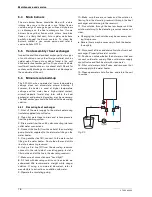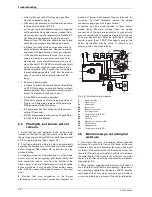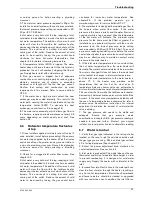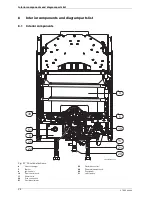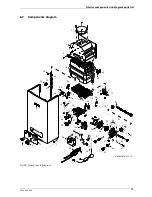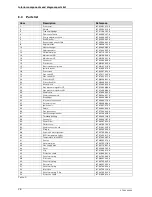
6 720 644 942
Troubleshooting
21
or service person for help correcting a plumbing
crossover.
3. The minimum water pressure required is 30psi. For
installation on a well system with use of a pressure tank,
the lowest pressure range setting recommended is 30-
50 psi (2.07-3.45 bar).
4. Hot water is very hot out of the tap, requiring a lot of
cold water to be added to it in order to attain a useable
hot water temperature. The addition of too much cold
water will slow the flow within the tankless heater,
decreasing it below activation point, which shuts off the
burners. The end result is nothing but cold water
coming out of the outlet. Reduce the amount of cold
water to be mixed by turning the gas control knob
clockwise for lower hot water temperatures. See
chapter 4.4 for details in lowering temperature.
5. A temperature limiter (ECO) is tripped. The water
heater does not have a thermostat. If the inlet water is
preheated, the unit will overheat, stopping the flow of
gas. Supply heater inlet with cold water only.
6. Flue gas sensor is tripped. Lack of adequate
combustion air or venting improperly by reducing pipe
diameter, improper use of elbows or exceeding
maximum vent length will trip the flue gas sensor.
Confirm that venting and combustion air meet
requirements in this manual. Refer to service bulletin
CT-03.
7. If the water has a high mineral content, the heat
exchanger may be scaled internally. This restricts the
water path, causing the water to overheat and trip the
temperature limiter (ECO). To descale the heat
exchanger, consult section 5.6 on page 18.
8. The water valve assembly, which allows gas flow to
the burners, requires periodic maintenance (every 2-5
years depending on water quality and use). See
section 5.2.
6.6
Hot water temperature fluctuates
at tap
1. Close installer supplied cold water shut off valve (if
none installed, install before proceeding). Open every
hot water tap supplied by the heater. Wait 5 minutes
and check all taps. Any water running, even a trickle, is
a sign of a plumbing crossover. Consult local plumber
or service person for help correcting a plumbing
crossover.
2. Check for a clogged inlet water filter screen. See
chapter 5.2.
3. Hot water is very hot out of the tap, requiring a lot of
cold water to be added to it in order to attain a useable
hot water temperature. The addition of too much cold
water will slow the flow within the tankless heater,
decreasing it below activation point, which shuts off the
burners. The end result is nothing but cold water
coming out of the outlet. Reduce the amount of cold
water to be mixed by turning the gas control knob
clockwise for lower hot water temperatures. See
chapter 4.5. If the problem persists, go to
www.boschpro.com for service bulletin CT-07.
4. The water heater is designed to modulate gas flow to
the burners when water flow varies. If the water
pressure in the home is erratic and the water flow is not
consistent while a tap is opened, then the temperature
of the hot water will fluctuate. The minimum water
pressure for the home must be 30psi or greater. For
installations on a private well system with the use of a
pressure tank, the lowest pressure range setting
recommended is 30-50psi (2.07-3.45 bar). The use of
a pressure reducing/regulating valve before the water
heater (directly after the pressure tank on well systems)
may be an effective way to maintain constant water
pressure to the water heater.
5. If the inlet water temperature is not consistent then
the hot water temperature from the water heater will
fluctuate. The water heater modulates its burners when
flow rate is changed. It does not have a thermostat and
will not adjust to changes in inlet water temperature.
6. If the inlet water temperature to the water heater is
above 70 F, the heater may produce outlet
temperatures that are too hot for most uses. A
temperature balance shower valve can automatically
mix in cold water to reduce very hot water temperatures.
This can slow the flow within the tankless water heater,
decreasing it below activation point, which shuts off the
burners. In the event of any temperature instability with
the use of a temperature balance shower valve, refer to
shower valve manufacturer instructions for internal
adjustment to minimize the amount of cold water the
valve is adding.
7. The gas pressure also needs to be stable and
adequate.
Ensure
that
gas
pressure
meets
specifications in chapter 3.8. A gas pressure reading is
needed to proceed further. Contact your original
installer or a local gas technician to obtain this reading.
6.7
Water is too hot
1. Verify that gas type indicated in the rating sticker
located on the cover's right hand side coincides with
the gas type you are using. NG is a natural gas unit and
LP is for liquid propane (See chapter 2.2).
2. Adjust the power adjustment knob clockwise for
cooler temperatures. See section 4.4.
3. Inlet water is preheated. This model does not have a
thermostat and will not modulate flame height in order
to prevent overheating. It is designed for cold water
supply only. Supply the heater with cold water to the
inlet.
4. Increase flow rate. Restrictions in the water path can
slow the flow of water through the heater, resulting in
very hot outlet temperatures. Restrictive showerheads
and faucet aerators should be cleaned or upgraded
with less restrictive ones. In addition, the inlet filter on












